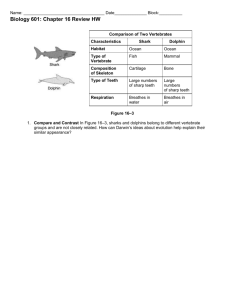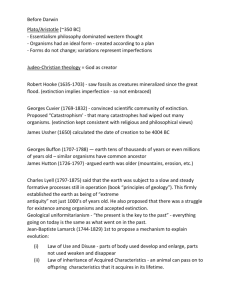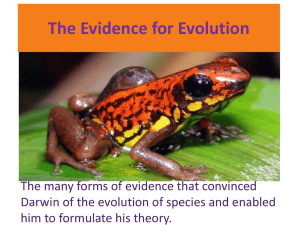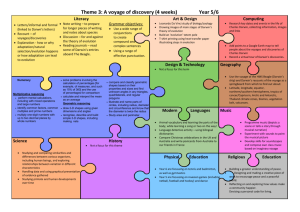Theory of Evolution by Natural Selection
advertisement
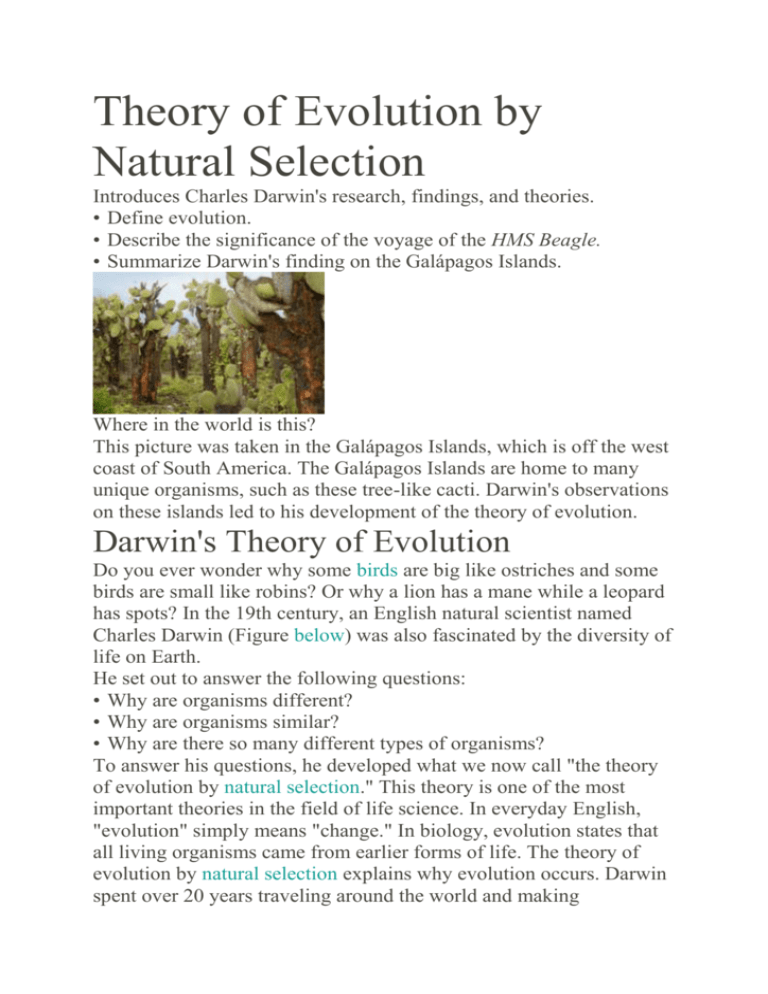
Theory of Evolution by Natural Selection Introduces Charles Darwin's research, findings, and theories. • Define evolution. • Describe the significance of the voyage of the HMS Beagle. • Summarize Darwin's finding on the Galápagos Islands. Where in the world is this? This picture was taken in the Galápagos Islands, which is off the west coast of South America. The Galápagos Islands are home to many unique organisms, such as these tree-like cacti. Darwin's observations on these islands led to his development of the theory of evolution. Darwin's Theory of Evolution Do you ever wonder why some birds are big like ostriches and some birds are small like robins? Or why a lion has a mane while a leopard has spots? In the 19th century, an English natural scientist named Charles Darwin (Figure below) was also fascinated by the diversity of life on Earth. He set out to answer the following questions: • Why are organisms different? • Why are organisms similar? • Why are there so many different types of organisms? To answer his questions, he developed what we now call "the theory of evolution by natural selection." This theory is one of the most important theories in the field of life science. In everyday English, "evolution" simply means "change." In biology, evolution states that all living organisms came from earlier forms of life. The theory of evolution by natural selection explains why evolution occurs. Darwin spent over 20 years traveling around the world and making observations before he fully developed his theory. Charles Darwin was one of the most influential scientists who has ever lived. Darwin introduced the world to the theory of evolution by natural selection, which laid the foundation for how we understand the living world today. Voyage of the HMS Beagle In 1859, Charles Darwin published his book, On the Origin of Species by Means of Natural Selection (often known as The Origin of Species). His book describes the observations and evidence that he collected more than 20 years of research, beginning with a five-year voyage around the world on a British research ship, the HMS Beagle. During the voyage (Figure below), Darwin made observations about plants and animals around the world. He also collected specimens to study for when he returned to England. Each time the HMS Beagle stopped at a port, Darwin went on land to explore and look at the local plants, animals, and fossils. One of the most important things Darwin did was keep a diary. He took detailed notes and made drawings of his observations. Charles Darwin’s famous five year voyage was aboard the HMS Beagle from 1831-1836. The Galápagos Islands While the crew of the HMS Beagle mapped the coastline of South America, they traveled to a group of islands called the Galápagos. The Galápagos are a group of 16 volcanic islands near the equator, about 600 miles from the west coast of South America. Darwin spent months on foot exploring the islands. The specimens he collected from the Galápagos and sent back to England greatly influenced his ideas of evolution (Figure below). The Galápagos Islands are a group of 16 volcanic islands 600 miles off the west coast of South America. The islands are famous for their many species found nowhere else. It was on these islands where Darwin began to develop his theory of evolution. On the Galápagos, Darwin observed that the same kind of animal differed from one island to another. For example, the iguanas (large lizards) differed between islands (Figure below). The members of one iguana species spent most of their time in the ocean, swimming and diving underwater for seaweed, while those of another iguana species lived on land and ate cactus. Darwin wondered why there were two species of iguanas on the same set of islands that were so different from one another. What do you think? The Galápagos iguanas are among the signature animals of the Galápagos Islands. Here both a land iguana and a marine iguana are shown. Giant Tortoises Darwin also observed giant tortoises on the Galápagos (Figure below). These tortoises were so large that two people could ride on them. Darwin noticed that different tortoise species lived on islands with different environments. He realized that the tortoises had traits that allowed them to live in their particular environments. For example, tortoises that ate plants near the ground had rounded shells and shorter necks. Tortoises on islands with tall shrubs had longer necks and shells that bent upward, allowing them to stretch their necks (Figure below). Darwin began to hypothesize that organisms developed traits over time because of differences in their environments. Darwin began to think that organisms evolved adaptations that allowed them to live in their environment. These adaptations were beneficial traits for their environment. The name “Galápagos” means “giant tortoise.” When Darwin arrived on the Galápagos Islands, he was amazed by the size and variety of shapes of these animals. The giant tortoise (left) is a unique animal found only in the Galápagos Islands. There are only about 200 tortoises remaining on these islands. This Pinta Island tortoise (right) is able to reach leaves high in shrubs with its long neck and curved shell. Darwin's Finches The most studied animals on the Galápagos are finches, a type of bird (Figure below). When Darwin first observed finches on the islands, he did not even realize they were all finches. But when he studied them further, he realized they were related to each other. Each island had its own distinct species of finch. The birds on different islands had many similarities, but their beaks differed in size and shape. Four of Darwin’s finch species from the Galápagos Islands. The birds came from the same finch ancestor. They evolved as they adapted to different food resources on different islands. The first bird uses its large beak to crack open and eat large seeds. Bird #3 is able to pull small seeds out of small spaces. In his diary, Darwin pointed out how each animal is well-suited for its particular environment. The shapes of the finch beaks on each island were well-matched with the seeds available on that island, but not the seeds on other islands. For example, a larger and stronger beak was needed to break open large seeds on one island, and a small beak was needed to eat the small seeds on a different island. Summary • Charles Darwin developed what we now call "the theory of evolution by natural selection." • Darwin's observations on the Galápagos Islands suggested that animals are well-suited for their specific environments. Review Hint -These are the questions you may be asked next class in a pop quiz 1 Define biological evolution. 2 Who was Charles Darwin? 3 What is special about the Galápagos islands? 4 Name an example of how animals were adapted for their specific environments on the Galápagos Islands.
